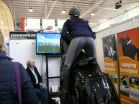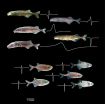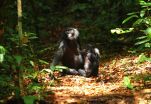Riding a horse is far more complex than riding simulators
2015-08-04
(Press-News.org) Flight simulators for the training of air pilots are well known. But what about riding simulators? Although the first horse simulator was used at the French National Equestrian School in Saumur already in the 1980s, riding simulators for dressage, show jumping, polo or racing, have become available only recently. They look like horses and respond to the aids of the rider via sensors which measure the force exerted by the reins and the rider's legs. Via a screen in front of the simulator, the rider immerses himself into a virtual equestrian world.
Simulators are aimed at competitive sports
Riders and jockeys use simulators to repeat movement sequences, improve their position in the saddle or simulate the finish of a race, but they also train to avoid injuries when falling off a horse. Jockeys also use riding simulators to regain their physical fitness after injuries. „A riding simulator always responds in the same way and thus allows standardised training programmes" says Natascha Ille from the Vetmeduni Vienna, first author of the study.
Riding a horse is more demanding
Ille and her co-workers from the Graf Lehndorff Institute for Equine Science, a joint research unit of the Brandenburg State Stud and the Vetmeduni Vienna, tested the response of 12 riders in a show jumping course. They compared the riders' stress hormones, heart rate and heart rate variability when riding a horse and a riding simulator.
The riders' heart rate was higher when riding a horse than during simulator-based training. „A horse is the bigger challenge compared to a simulator. The movement characteristics of a horse are more complex and the response of a horse in a given situation is only partially predictable. Riding a simulator is thus physically and psychologically less demanding for riders", explains Ille.
Heart rate data indicate that the training on a horse had a more pronounced stimulatory effect on the riders` sympathetic nervous systems compared to the training on the simulator. Sympathetic activity is known to increase the body´s performance potential in sportive activities.
Analysis of the stress hormone cortisol in saliva collected from the riders also suggests a stress reaction on the simulator. „This may be due to a novel experience for the riders. Participants in the study had never trained on a simulator before, but were well accustomed to working with horses", Ille suggests.
„Our results demonstrate that riding a horse is far more complex for the human body than riding a simulator", summarises project supervisor Jörg Aurich. „However, riding simulators could be an excellent preparation for beginners before they mount a horse for the first time. For competitive riders and jockeys, simulators could be a valuable addition to the training with horses".
INFORMATION:
Service:
The article "Riding simulator training induces a lower sympathetic response in riders than training with horses", by Natascha Ille, Mareike von Lewinski, Christine Aurich, Regina Erber, Manuela Wulf, Rupert Palme, Bill Greenwood and Jörg Aurich was published in the Journal of Equine Veterinary Science. doi:10.1016/j.jevs.2015.06.018
Video:
https://www.youtube.com/watch?v=b0zqWJUaZnk&feature=youtu.be
About the University of Veterinary Medicine, Vienna
The University of Veterinary Medicine, Vienna in Austria is one of the leading academic and research institutions in the field of Veterinary Sciences in Europe. About 1,300 employees and 2,300 students work on the campus in the north of Vienna which also houses five university clinics and various research sites. Outside of Vienna the university operates Teaching and Research Farms. http://www.vetmeduni.ac.at
Scientific Contact:
Natascha Ille
Insemination and Embryotransfer Platform
University of Veterinary Medicine Vienna (Vetmeduni Vienna)
T +43 1 25077-5402 or +43 1 25077-6422
natascha.ille@vetmeduni.ac.at
Released by:
Susanna Kautschitsch
Science Communication / Public Relations
University of Veterinary Medicine Vienna (Vetmeduni Vienna)
T +43 1 25077-1153
susanna.kautschitsch@vetmeduni.ac.at
[Attachments] See images for this press release:

ELSE PRESS RELEASES FROM THIS DATE:
2015-08-04
Scientists first had to re-think death before they could develop a way of testing the potential harm to the environment caused by thousands of chemicals humankind uses each day.
Researchers led by Dr Roman Ashauer, of the Environment Department at the University of York, refined the technique of survival analysis used routinely by toxicologists, biologists, medical researchers and engineers. The research could pave the way for testing the estimated 15,000 substances discovered daily.
Survival analysis which helps to predict a huge range of functions such as the survival ...
2015-08-04
New research by scientists at New Zealand's University of Otago and GNS Science is helping to solve the puzzle of how bacteria are able to live in nutrient-starved environments. It is well-established that the majority of bacteria in soil ecosystems live in dormant states due to nutrient deprivation, but the metabolic strategies that enable their survival have not yet been shown.
The researchers took an extreme approach to resolving this enigma.
They studied a strain of acidobacteria named Pyrinomonas methylaliphatogenes that was cultivated from heated and acidic geothermal ...
2015-08-04
A study including researchers from the U.S. Department of Energy's Argonne National Laboratory and the University of Chicago found evidence that gut microbes affect circadian rhythms and metabolism in mice.
We know from studies on jet lag and night shifts that metabolism--how bodies use energy from food--is linked to the body's circadian rhythms. These rhythms, regular daily fluctuations in mental and bodily functions, are communicated and carried out via signals sent from the brain and liver. Light and dark signals guide circadian rhythms, but it appears that microbes ...
2015-08-04
The more than 200 species in the family Mormyridae communicate with one another in a way completely alien to our species: by means of electric discharges generated by an organ in their tails.
In a 2011 article in Science that described a group of mormyrids able to perceive subtle variations in the waveform of electric signals, Washington University in St. Louis biologist Bruce Carlson, PhD, noted that another group of mormyrids are much less discriminating (see illustration).
The fish with nuanced signal discrimination can glean a stunning amount of information from ...
2015-08-04
Cleaning up municipal and industrial wastewater can be dirty business, but engineers at the University of Colorado Boulder have developed an innovative wastewater treatment process that not only mitigates carbon dioxide (CO2) emissions, but actively captures greenhouse gases as well.
The treatment method, known as Microbial Electrolytic Carbon Capture (MECC), purifies wastewater in an environmentally-friendly fashion by using an electrochemical reaction that absorbs more CO2 than it releases while creating renewable energy in the process.
"This energy-positive, carbon-negative ...
2015-08-04
(BOSTON) - Super productive factories of the future could employ fleets of genetically engineered bacterial cells, such as common E. coli, to produce valuable chemical commodities in an environmentally friendly way. By leveraging their natural metabolic processes, bacteria could be re-programmed to convert readily available sources of natural energy into pharmaceuticals, plastics and fuel products.
"The basic idea is that we want to accelerate evolution to make awesome amounts of valuable chemicals," said Wyss Core Faculty member George Church, Ph.D., who is a pioneer ...
2015-08-04
Some neutron stars may rival black holes in their ability to accelerate powerful jets of material to nearly the speed of light, astronomers using the Karl G. Jansky Very Large Array (VLA) have discovered.
"It's surprising, and it tells us that something we hadn't previously suspected must be going on in some systems that include a neutron star and a more-normal companion star," said Adam Deller, of ASTRON, the Netherlands Institute for Radio Astronomy.
Black holes and neutron stars are respectively the densest and second most dense forms of matter known in the Universe. ...
2015-08-04
From an early age, human infants are able to produce vocalisations in a wide range of emotional states and situations - an ability felt to be one of the factors required for the development of language. Researchers have found that wild bonobos (our closest living relatives) are able to vocalize in a similar manner. Their findings challenge how we think about the evolution of communication and potentially move the dividing line between humans and other apes.
Animal vocalisations are usually made in relatively narrow behavioural contexts linked to emotional states, such ...
2015-08-04
Washington, DC-- Climate change caused by greenhouse gas emissions will alter the way that Americans heat and cool their homes. By the end of this century, the number of days each year that heating and air conditioning are used will decrease in the Northern states, as winters get warmer, and increase in Southern states, as summers get hotter, according to a new study from a high school student, Yana Petri, working with Carnegie's Ken Caldeira. It is published by Scientific Reports.
"Changes in outdoor temperatures have a substantial impact on energy use inside," Caldeira ...
2015-08-04
A team of scientists believe they have shown that memories are more robust than we thought and have identified the process in the brain, which could help rescue lost memories or bury bad memories, and pave the way for new drugs and treatment for people with memory problems.
Published in the journal Nature Communications a team of scientists from Cardiff University found that reminders could reverse the amnesia caused by methods previously thought to produce total memory loss in rats. .
"Previous research in this area found that when you recall a memory it is sensitive ...
LAST 30 PRESS RELEASES:
[Press-News.org] Riding a horse is far more complex than riding simulators


